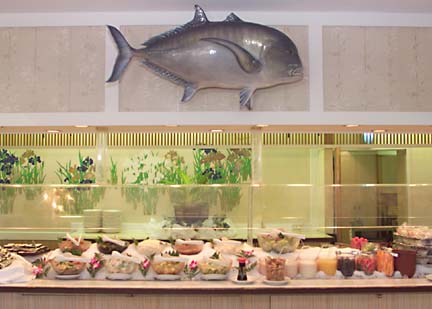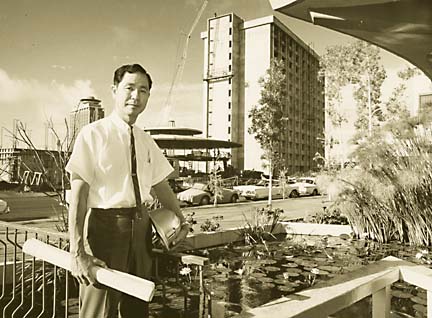

|
40 years afloat
The Pagoda celebrates a milestone
|
The Pagoda is celebrating its 40th anniversary this week, having firmly secured its place on the list of island institutions.
If you've been in Hawaii for any chunk of those 40 years, there's little doubt you've been to the Pagoda. If your memories are not of the "international buffet," perhaps they cover the old Lotus Room upstairs with its kimono-clad waitresses, or the garden and koi ponds, or the C'est Si Bon Nightclub, where magician David Copperfield got his start. Or perhaps you stayed in the hotel, where the rooms were always cheaper than anything in Waikiki.
Norito Fujioka remembers visiting the restaurant the week it opened in 1964, and how he quickly became a regular; he still comes twice a week, usually for breakfast. "We used to bring our guests here in the evening," he says. "They used to have this combination -- lobster and beef. It was really good."
What Fuijioka couldn't be expected to remember was the price: Combination Steak and Lobster, $3.50.
The Pagoda's old menus are a gift of nostalgia. Lobster Curry, $2.95; Alaskan King Crab Leg and Claw (lunch portion), $1.95. But, hey, consider the times. A room in the hotel went for $7.50 per night; a month lease was $125, including telephone and utilities.
May 2, 1964: Opening day. Beverly Shimabukuro (no relation to this writer) was a young waitress in the Lotus Room, decked out in a kimono and passing out menus printed on fans with bamboo handles.

|
"We were really busy ... a lot of local people," she recalls.
But the first year did not go smoothly. Organization was poor and there was lots of confusion. "We had a hard time," Shimabukuro says. "We weren't prepared, there was no training. They just put us on the floor ... and go."
But things got better and the restaurant hit its stride. Downstairs, a salad bar morphed into a buffet, a huge draw for local crowds. The drew major local acts, from the Aliis to Zulu -- and a non-local, a young man named Copperfield.
Shimabukuro remembers the magician well. "He used to come into the kitchen during the breaks and he always had beef teriyaki."
Copperfield sent an anniversary message, remembering the Hayashi family that owns the Pagoda: "They gave me my first real gig. I was about 19, and to perform at their club, night after night; to hone my skills and work on my chops in front of terrific audiences -- in beautiful Hawaii, no less -- was a dream come true."
The Lotus Room has since become the LaSalle Lounge, used primarily for banquets, and Shimabukuro long ago moved downstairs to the Floating Restaurant, where she works the breakfast shift. "I guess this is my destiny."

|
The hotel, the restaurant, the distinctive Japanese architectural design and the koi ponds that give the restaurant its "floating" look were all the vision of developer Herbert T. Hayashi, known then and now as "H.T."
Locating his $2.3 million project outside the resort area of Waikiki was a risky notion, says Ed Saunders, the Pagoda's current general manager. "H.T. built a hotel 2 1/2 miles from where all the action was. He wanted to give value to local people from the neighbor islands."
Saunders is another longtime Pagoda employee. He remembers H.T. -- now in his 80s and semi-retired -- as an extremely particular boss who frequently pointed out the little things -- trash on the floor, gum on the carpet -- that he believed reflected poorly on the establishment.
John Hayashi, vice president of the family business, says H.T. ate breakfast in the restaurant every morning, the better to check up on everyone. He still does so on occasion, although he's left the business in the hands of his daughter, Corrine, since a stroke seven years ago.
John Hayashi came to Hawaii in 1979 from Hiroshima, Japan, to work in his uncle's company. Although he had a business degree, H.T. made him start as a bus boy.
Each morning, H.T. would call his nephew over, often for a lesson in customer service. He hated to wait, Hayashi says, and assumed that customers did, too. "He would say, 'Look at their faces: That guest is looking for a waiter; that guest is waiting for coffee, or water, or whatever.' "

|
Hayashi says his uncle was a determined businessman who would set goals and act quickly. HTC Corp. now includes not only the Pagoda, but also the Pacific Beach Hotel in Waikiki and the King Kamehameha Hotel in Kona, testament to the validity of his instincts.
There was a notable exception, however.
The French era -- or "error," as Saunders labels it -- came in the late 1980s, when Hayashi thought he'd take advantage of a growing interest in upscale cuisine by converting the Lotus Room into a French restaurant.
Shimabukuro remembers trading her waitress' kimono in for a tuxedo shirt and taking a crash course in French cuisine. "We even had to go to classes to learn how wine is made." Many of the Japanese-speaking waitresses were intimidated and quit, she says. "I just faked it."
The public was underwhelmed -- "because the Pagoda Hotel is so local-fied," Saunders says. After five years, the experiment ended.

|
All eventually was forgiven, though. The Pagoda Floating Restaurant serves about 250 customers at breakfast and another 400 divided between lunch and dinner. The buffet represents the bulk of the business. "We have menus," Saunders says, "but they're hardly ever opened."
In a competitive business where change is constant, the Pagoda has stayed the course. "The specialness of the Pagoda is it hasn't really changed that much," Saunders says. "And it's very local."
Now, there'd be a gaping hole in this reminiscence without a few words about the fish, which have been part of the Pagoda's identity since the beginning. Raising fish was a hobby of H.T.'s, and he believed making them part of the restaurant would not just provide a point of interest, but also a dose of serenity.
The ponds surrounding the restaurant hold close to 1,000 koi. Papio (baby ulua) were first added to the ponds in the 1980s and 15 whopper-sized adults live there now.

|
"The oldest fish are probably 20 years old," Saunders says. "We actually had some that were probably pushing the 30-age-range and weighed up to 80 pounds."
The fish are fed daily at noon and cared for until they die of natural causes. They are never eaten, Saunders emphasizes.
One gigantic ulua does grace the buffet line, though, and it looks as though it might have been one of those 80-pounders. Stuffed and mounted, the massive fish is fixed to the wall, high above bowls of salads set in a bed of ice, its steady gaze fixed on customers carrying their dinner plates down the line.
www.pagodahotel.com/din.cfm

Click for online
calendars and events.